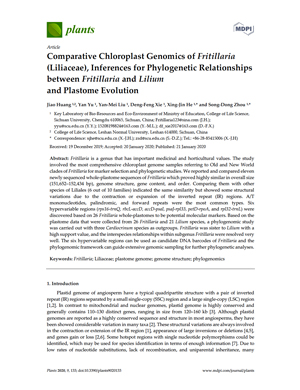NEWS 2020
Comparative Chloroplast Genomics of Fritillaria (Liliaceae), Inferences for Phylogenetic Relationships between Fritillaria and Lilium and Plastome Evolution
Jiao HUANG1,2, Yan YU1, Yan‐Mei LIU1, Deng‐Feng XIE1, Xing‐Jin HE1, Song‐Dong ZHOU1
Plants 9(2): 133–147 (2020)
doi:10.3390/plants9020133
1Key Laboratory of Bio‐Resources and Eco‐Environment of Ministry of Education, College of Life Science, Sichuan University, Chengdu 610065, Sichuan, China
2College of Life Science, Leshan Normal University, Leshan 614000, Sichuan, China
Abstract
Fritillaria is a genus that has important medicinal and horticultural values. The study involved the most comprehensive chloroplast genome samples referring to Old and New World clades of Fritillaria for marker selection and phylogenetic studies. We reported and compared eleven newly sequenced whole‐plastome sequences of Fritillaria which proved highly similar in overall size (151,652–152,434 bp), genome structure, gene content, and order. Comparing them with other species of Liliales (6 out of 10 families) indicated the same similarity but showed some structural variations due to the contraction or expansion of the inverted repeat (IR) regions. A/T mononucleotides, palindromic, and forward repeats were the most common types. Six hypervariable regions (rps16‐trnQ, rbcL‐accD, accD‐psaI, psaJ‐rpl33, petD‐rpoA, and rpl32‐trnL) were discovered based on 26 Fritillaria whole‐plastomes to be potential molecular markers. Based on the plastome data that were collected from 26 Fritillaria and 21 Lilium species, a phylogenomic study was carried out with three Cardiocrinum species as outgroups. Fritillaria was sister to Lilium with a high support value, and the interspecies relationships within subgenus Fritillaria were resolved very well. The six hypervariable regions can be used as candidate DNA barcodes of Fritillaria and the phylogenomic framework can guide extensive genomic sampling for further phylogenetic analyses.




